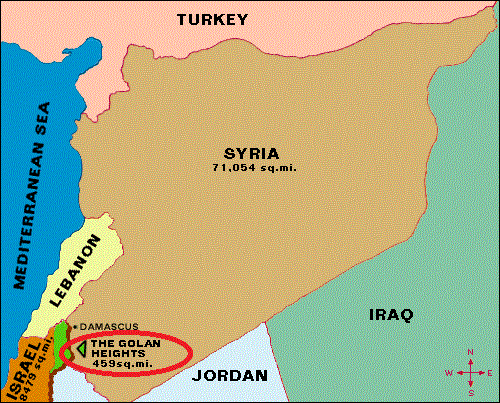Description

Disclaimer: Copyright infringement not intended.
Context
India has voted in favour of a draft resolution in the UN General Assembly that expressed deep concern over Israel not withdrawing from the Golan Heights.
About
- It is a rocky plateau in southwestern Syria, about 60 kilometers (40 miles) south of Damascus.
- The Jordan River and the Sea of Galilee border it on the west, Mount Hermon on the north, the seasonal Wadi Al-Ruqqd River on the east, and the Yarmk River on the south.
- At its broadest point, the Golan measures approximately 44 miles (71 kilometers) from north to south and 27 miles (43 kilometers) from east to west.
- It is somewhat boat-shaped and covers 1,150 square km.
Why is the Golan Heights a source of contention?
- Syria controlled the Golan Heights until 1967.
- During the Six-Day War in 1967, Israel took the majority of the territory, occupying it and annexing it in 1981.
- After annexing the Golan, Israel offered citizenship to the Druze, but the majority declined and continued to identify as Syrians.
- Another 20,000 Israeli settlers live there as well, many of whom work in agriculture and tourism.
- Israel's unilateral acquisition was not accepted internationally, and Syria wants the region to be returned.
- Syria attempted to reclaim the Heights during the 1973 Middle East conflict but was unsuccessful.
- Since Israel and Syria signed a peace treaty in 1974, the Golan Heights has been generally peaceful.
- Israel and Syria had their highest-level discussions in 2000 to discuss the probable return of the Golan Heights and a peace accord.
- However, the negotiations failed, and subsequent talks also failed.

Why do the countries claim the Golan Heights?
- Both sides want the Golan's abundant water and naturally productive land.
- Furthermore, given Syria's civil conflict, Israel views the plateau as a buffer zone between Israeli communities and the instability in Syria.
- Israel is also concerned that Iran is attempting to permanently position itself on the Syrian side of the border to launch strikes on Israel.
- Notably, Iran is a supporter of Syrian President Bashar al-Assad.
- Syria, for its part, insists that the part of the Golan held by Israel remains an occupied territory and thus demands its return.
What is the current UN arrangement there?
- A United Nations Disengagement Observer Force (UNDOF) is stationed in camps and observation posts along the Golan.
- This is supported by military observers of the United Nations Truce Supervision Organization (UNTSO).
- Between the Israeli and Syrian armies is a 400-square-km “Area of Separation”.
- This is often called a demilitarized zone in which the two countries’ military forces are not permitted under the ceasefire arrangement.
- The Separation of Forces Agreement of 1974 created two lines of separation.
- Behind the Alpha Line to the west of the area of separation, Israeli military forces must remain.
- Behind the Bravo Line to the east of the area of separation, Syrian military forces must remain.
- Extending 25 km beyond the “Area of Separation” on both sides is an “Area of Limitation”.
- Here, there are restrictions on the number of troops and the number and kinds of weapons that both sides can have.
- There is one crossing point between the Israeli and Syrian sides.
- Until the Syrian civil war broke out in 2011, this was used mainly by UN forces, a limited number of Druze civilians, and for the transportation of agricultural produce.
Strategic Importance
- There are more than 30 Israeli settlements in the Golan.
- The settlements are considered illegal under international law, although Israel disputes this.
- About 20,000 Syrians and 20,000 Israelis live in the Golan.
- The Syrian capital, Damascus, can be seen from the top of the Golan Hills.
- When it rains here, its water goes to the Jordan River, which supplies water in dry areas. It is believed that this water supplies one-third of Israel's water.
- Apart from this, the land here is very fertile, which is very good for farming.

More About the News
- Draft resolution: The draft resolution ‘The Syrian Golan ' was put to vote at the UN General Assembly, under the agenda item ‘The situation in the Middle East’.
- Voting on resolution: The resolution, presented by Egypt, secured adoption through a recorded vote, garnering 91 in favor, eight against, and 62 abstentions.
- Supporting countries: In addition to India, countries that supported the resolution included Bangladesh, Bhutan, China, Malaysia, Maldives, Nepal, Russia, South Africa, Sri Lanka, and the United Arab Emirates.
- Countries against the resolution: Australia, Canada, Israel, the UK, and the US voted against it.
- Israel’s failure: The resolution expressed deep concern over Israel’s failure to withdraw from the Syrian Golan Heights in violation of Security Council and General Assembly resolutions.
- No adherence to UNSC resolution 497: The resolution affirmed that Israel had not adhered to Security Council resolution 497 (1981).
- The resolution asserted that the Israeli decision made on December 14, 1981, is deemed null and void and holds no validity. It urged Israel to revoke this decision.
- Resolution on Israeli settlements: The resolution emphasized the illegitimacy of Israeli settlement construction and other activities in the Syrian Golan Heights occupied since 1967.
- It called for Israel’s withdrawal from the entire occupied Syrian Golan under relevant Security Council resolutions.
|
PRACTICE QUESTION
Discuss the historical background, key issues, and international dimensions of the Israel-Palestine conflict. How has the conflict evolved, and what are the major challenges in achieving a sustainable resolution?
|











